
Original Link: https://www.anandtech.com/show/2764
EVGA X58 Classified - Trophy Board
by Rajinder Gill on May 8, 2009 3:30 AM EST- Posted in
- Motherboards
Our retail board arrived last week and now we aim to tie up the loose ends we left in our first look using the engineering sample (ES) board. The loose ends revolve around cooling, additional heavy OC stuff (for the intended audience), and functionality.
Not many people can afford a $449 motherboard. In fact, we seriously doubt anyone in his or her right mind would pay that much for a motherboard not installed in a server responsible for a company's business. However, there are the few, the proud, the extreme benchmarking crowd who swoon over products like this one.
We have spent a lot of time with this board. Probably too much time, once we looked over the logbook and thought back to the first day our early engineering sample board arrived in the labs. We were there during the development phase and stuck with it all the way through to its release. We never regretted the journey and sound like sentimental fools at this point, but it's not too often a product like this comes along in our business.
It is an interesting product and one we cannot put down long enough to write a ten thousand-word diatribe for it. This board is a beast; it makes no apologies for its cost, its purpose, or in your face configuration. It only asks that you have enough knowledge about overclocking to get the most out of it. That really is the crux of this board as it is all about overclocking.
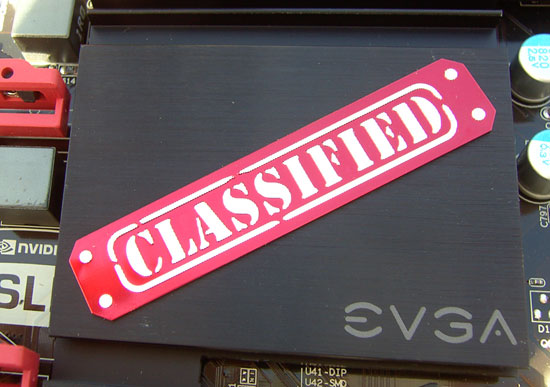
For those not interested in extreme overclocking or wanting a trophy board in their pimped out case, there are much better values in the land of X58. Keep this in mind as our follow up today concentrates on overclocking and not general performance. The board performs just as well as any other X58 motherboard when it comes to running Excel or transcoding the latest movie. In 3D gaming, it is a couple of percent slower than the boards without the NF200, but that penalty is never noticeable without a benchmark.
If this is a deal breaker for you and you would like to play with the Classified design sans NF200, you will be pleased to know this option is now available on a non-NF200 model (E760) that comes in at a slightly lower price of $399. We cannot address the performance loss or overclocking ability of A vs. B at this point, as our non-NF200 Classified board has not arrived. However, we will hedge our bets that performance figures in most standard hardware configurations will be the same as what we have already experienced, with the NF200 GPU intensive stuff 1-2% behind the non-NF200. We think one advantage the NF200 board might have is in extreme overclocking as the load on the X58 is reduced, but more on that later.
For now, let's look at what the NF200 Classified can do in full retail form when teamed up with the right components and is properly tuned.
The Board
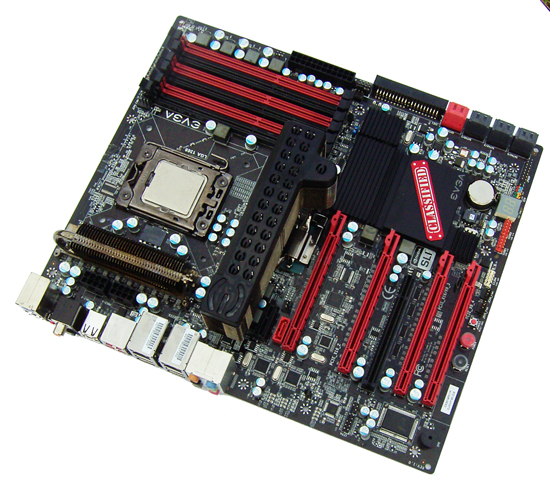 |
The final rendition of the heatsink is a little smaller than what was on our ES sample. The reduction in size makes the heatsink compatible with the bulkier CPU coolers and allows the use of a "long" soundcard in the top PCI-E slot. Feature wise, everything we mentioned in our ES preview made it to retail release.
The ES board did leave us hopeful of a release with minimal end-user issues. On the BIOS front at time of publication, the one remaining requested fix is proper CPU FAN Speed recovery from S3 Sleep states. EVGA is addressing this and a fix should be ready shortly.
A certain amount of "pickiness" has also been revealed with certain batches of PSUs. We've encountered no problems ourselves using the venerable PCP 1200W and Corsair HX1000w PSUs. Based on these problems and ones that we have experienced with other X58 boards, we suspect the problems are with start-up current protection timing on older units. We recommend you head over to the EVGA forums to see if your PSU is on the potential hazard list before you purchase the components for your build. Units from Enermax and Thermaltake seem to be those with the most compatibility issues thus far, although not all batches seem affected, suggesting that revisions are already in the wild.
The retail board exhibited excellent compatibility with our own test hardware. Everything from onboard sound to various USB devices and peripheral cards including RAID controllers works. We can find nothing negative when it comes to overall functionality of the board.
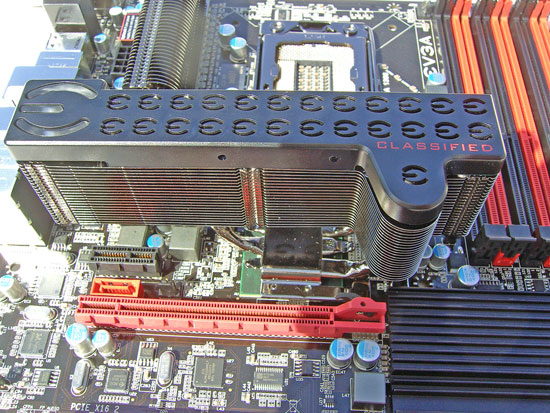
Despite its size, the IOH cooler employed by EVGA on the Classified is not suitable for passive cooling of the IOH/ICH and NF200 when used in a closed PC case during overclocking runs. We have found temperatures can easily soar over 80C if there is no cross-flow across the heatsink. EVGA's design allows the user to mount a small 40mm fan to the PCI-E slot side of the heatsink that should help reduce temperatures into the 50C region and ensure stability when overclocking.
Unfortunately, you will have to buy a fan separately, which we think should have been included in the retail package considering the price of the motherboard. A well-executed waterblock option with a heatpipe linking all critical areas would also have been welcome on a board in this price range. Active cooling of this heatsink is necessary in any overclocking configuration; expect overclocking and even stock stability in poorly ventilated cases to be somewhat flaky without some form of cross-flow.
CPU side mounting holes are not provided, because the space between the heatsink and most of the larger CPU coolers is not sufficient to place a dedicated fan into this area. It is possible to mount coolers like Thermalright Ultra 120 or Noctua NHU12P in either direction. There's just enough room to allow for push-pull fan configurations too, leaving a paper width of space between either the memory modules and the fan or the IOH heatsink and the fan in both orientations.
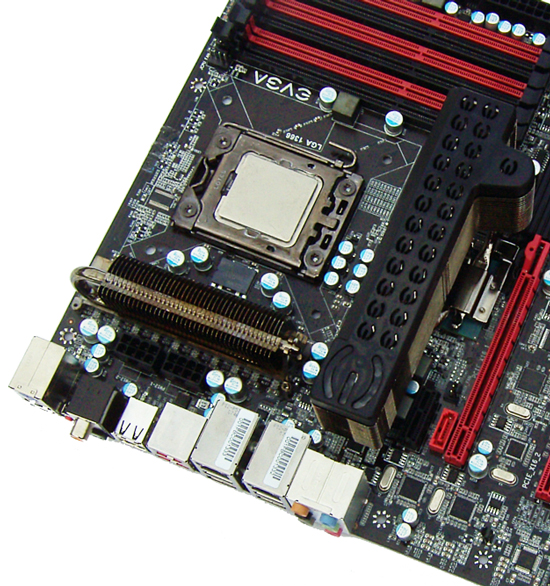
The PWM heatsink is segregated from the IOH heatsink and cools both the PWM FET's and inductors. The low voltage situations experienced in daily use do not require active cooling in this area. However, you'll find that cross-flow is again needed to keep temps in the 40-50C region when overclocking as the heat dump from the FET's and Inductors into the sink becomes quite substantial as soon as you elevate VID above 1.4V or so. It's not always easy getting airflow into this area of a board either. Again, a 40mm fan will suffice for the most part, but you'll probably have to find some way of balancing it around the heatsink or using a case like the CM Stacker 830 with fans in the side door that blow air across the board.
Specifications and Features
| EVGA X58 Classified | |
| Market Segment | Enthusiast and Extreme Benchmarking |
| CPU Interface | LGA-1366 |
| CPU Support | LGA-1366 Nehalem i7 Series of Processors |
| Chipset | Intel X58 |
| BCLK Speeds | 133~500 MHz in 1MHz increments |
| DDR3 Memory Speed | 800, 1067, 1333, 1600, 1867, 2133, 2400, 2667, 2933 Frequency Ratios |
| Uncore Frequency | Full i7 Processor IMC multipliers supported, Options available as per CPU |
| PCIe Speeds | Auto, 100MHz - 140MHz in 1MHz increments |
| Core Voltage | Auto, 1.00V to 2.24V in 0.00625V increments |
| CPU Vdroop Compensation | Enabled, Disabled |
| CPU Clock Multiplier | Dependant on Processor, all available multipliers supported |
| DRAM Voltage DDR3 | Auto, 0.70V ~ 3.39V in 10mV increments, 1.50V standard |
| DRAM Timing Control | tCL, tRCD, tRP, tRAS, + 17 additional timings + Chipset Configuration |
| DRAM Command Rate | Auto, 1T, 2T |
| IOH Voltage | 1.10V - 1.875V in 25mV increments |
| ICH Voltage | Auto, 1.05V ~ 1.825V in 25mV increments |
| CPU VTT (Uncore) Voltage | Auto, 1.17V ~ 2.17V in 25mV increments |
| CPU PLL Voltage | Auto, 0.60V ~ 2.70V in 75mV increments, 1.80V Base |
| IOH PLL Vcore | Auto, 0.60V ~ 2.70V in 75mV increments, 1.80V Base |
| QPI PLL Vcore | Auto, 1.10V ~ 1.875V in 25mV increments, 1.10V Base |
| IOH/ICH Voltage | Auto, 1.50V ~ 2.275V in 25mV increments, 1.50V Base |
| NF200 Voltage | Auto, 0.70v~1.075V in 125mV increments, then 1.20V~2.70V in 25mV increments. 1.20V Base |
| Memory Slots | Six 240-pin DDR3 DIMM Slots Triple-Channel Configuration Regular Unbuffered DDR3 Memory to 12GB Total |
| Expansion Slots | 4 - PCIe 2.0 x16, Supports up to NVIDIA 3-way SLI Technology + PhysX 1 - PCIe (1.x) x1 1 - PCI Slot 2.2 |
| Onboard SATA/RAID | 6x SATA 3.0Gbps Ports - Intel ICH10R Hot Plug and NCQ Support, RAID 0, 1, 5 RAID 0+1 Support and Intel Matrix Technology Support |
| Onboard IDE and Additional SATA | 2xJMicron JMB363 PATA (up to 2 UDMA 133/100/66 devices) 1 External eSATA port + 3 Internal JMB363 SATA Ports |
| Onboard USB 2.0 and IEEE-1394 | 10 USB 2.0 Ports - (8) I/O Panel, (2) via headers 1x 1394a Ports - (1) I/O Panel, (1) via header |
| Onboard LAN w/Teaming | Dual Realtek RTL8111C PCIe Gigabit Ethernet Controllers |
| Onboard Audio | Realtek ALC 889 - 8 Channel HD audio codec |
| Power Connectors | ATX 24-pin, Dual 8-pin ATX 12V |
| I/O Panel | 1 x PS/2 Keyboard 1 x eSATA 1 x SPDIF - Coaxial Out, 1 x Toslink Optical Out 1 x IEEE 1394 2 x RJ45 6 x Audio Out 8 x USB 2.0/1.1 |
| Fan Headers | 1 CPU + 4 Additional Headers |
| Fan Control | Full Fan speed Control Via BIOS |
| BIOS Revisions Used | IX58S21R |
Overall layout is excellent with everything accessible enough even when the board is fully loaded. The ECP panel allows remote positioning of power, reset, hex code, and PCI-E disable jumpers as well as VCore boost options in 0.1V steps totaling a maximum 0.3V overvolt on-the-fly. There are only four fan headers available (three with fan control via the BIOS) on the board, but positioning of each one is reasonably good and allows access in all configurations.
Slot layout is a big feature of the X58 Classified board, allowing multiple GPU configurations and a discrete soundcard to be used in tandem. When loaded fully, the NF200 provides the following lane allocation to the PCI-E slots: with three of the x16 mechanical slots loaded the lane allocation is 16x-16x-16x; with all four x16 slots loaded, the allocation is 16x-16x-8x-8x.
Realtek's ALC 889 fills the role of onboard sound here - nothing special, but it does work reasonably well in Vista. Hardcore gamers tend to veer towards the Creative Labs range or vendors like ASUS and Auzentech for alternative solutions. That said, the ALC 889 is clear enough and offers decent detailed audio in games and music, but lacks the wide midrange and bass punch of a dedicated soundcard. It is also a little low in maximum signal gain but not too bad compared to other onboard solutions. Microphones needing higher levels of gain or lower impedance headphones will lack a bit of clarity and overall volume when driven by the onboard Realtek solution.
The lower power rails (such as PLL circuitry) are all supplied by linear regulators, which offer low noise and clean power into sensitive circuitry. This does result in a higher overall heat dump into the motherboard PCB, but such side effects are expected on a board that attempts to break down all potential barriers for achieving high processor clocks with subzero cooling. Included in the hardware bundle are SATA/IDE cables, USB/FireWire extension headers, the ECP panel, three different SLI bridges for multi-GPU setups, and SATA to Molex converter cables. Packaging is excellent and both of our boards arrived from overseas shipping locations without any component or motherboard damage.
EVGA's excellent E-LEET software is part of the Classified's repertoire. We think this software is the best OS tweaking utility currently available from a manufacturer. A simple and clean interface based upon the CPU-Z GUI allows software level control of voltages and bus speed manipulation with minimal system overhead. This means you will not be hindered in achieving maximum overclocks due to system loads imposed by unnecessary graphical fluff and light shows. All of our heavier overclocks were obtained using E-LEET, saving us a tremendous amount of time compared to the set and reboot process. Temperature monitoring is also offered, although it's curiously lacking a temperature report for the IOH, which given the need for active cooling would be an appreciated addition. If EVGA could devise a way to offer memory tweaking then E-LEET would be close to our personal favorite, abit's wonderful uGuru program. Of course, EVGA is still in business so we can let that slide for now.
Testbed Setup
| EVGA X58 Classified Overclocking / Benchmark Testbed |
|
| Processor | Intel Core i7-920 D0 - Batch 3850A796 Quad-core, 2.66GHz Cache, 20x Multiplier (21x Turbo). 4X256K L2 Cache 8M L3 Cache |
| CPU Voltage | Various |
| Cooling | Dtek Fuzion CPU cooler, 2 x PA120.2 Radiators, 3X Noctua NF-P12 120MM fans, DDC Ultra with Petra top. Dual Cascade cooling 2x1.5HP rotary compressors |
| Power Supply | PCP 1200W |
| Memory | Corsair Dominator GT 7-8-7-20 2000MHz 6Gb kit. |
| Memory Settings | Various |
| Video Cards | MSI 4870X2 |
| Video Drivers | Catalyst 9.4 |
| Hard Drive | Western Digital 7200RPM 250GB SATA 3/Gbps 16MB Buffer |
| Optical Drives | Plextor PX-B900A, Toshiba SD-H802A |
| Case | Open Test Bed - Dimastech Benching Station, Lian-Li V2110 |
| BIOS | IX58S21R |
| Operating System | Vista 64 Bit SP1 |
| . | |
Base gaming benchmarks are located here. All other system benchmarks follow the same X58 board trend - nothing more than a 0.5%~1% difference between each board. Our focus today is aimed at the heavy overclocking side, which is what the Classified is all about.
Since the preview, we have received a number of BIOS releases with each adding a touch more functionality and addressing problems that were brought to light since the launch. Functionality wise, the board is 99.5% complete. The remaining fix addresses S3 fan speed resume which works fine for some users and not others. Overclocking enhancements have also been made to earlier BIOSes, with individual adjustments to memory timing functions like Round Trip Latency available for user manipulation to help maintain system stability at higher memory clock speeds.
On the overclocking front, we have found the Classified offers a little more stability at lower system voltages when compared with the EVGA X58 SLI or other boards in its price range. In 24/7 systems, the differences are relatively small and not something we'd pinpoint as a clear win, although any gains in this department are always desirable. The real test comes when the boards are pushed under subzero cooling, which is where the Classified is head and shoulders above the pack in our testing to date. So let's see where things get truly interesting for those who love to benchmark....
Classified + 920 D0 meets Cascade and LN2
Initial subzero tests were all performed using our large cascade unit and retail 920 D0 processor (batch 3850A796). A few hours of tuning heralded some truly remarkable results taking our i7-920 to over 5GHz for WPrime stability.
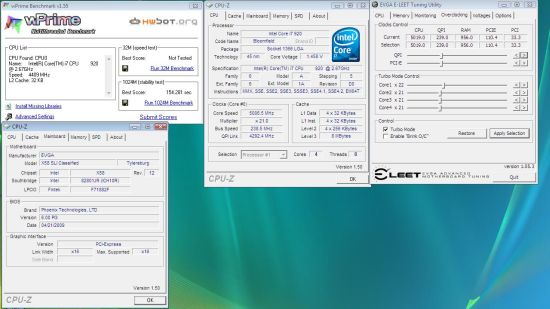 239BCLK for Wprime, pushing out the envelope on a 920 CPU |
An eight-threaded benchmark-stable BCLK of 239 on the 21X multiplier is astounding, upstaging most Extreme Edition 965 processors. This was merely the beginning though, as we pushed further to see where the board would land in the rigorous CPU test of 3DMark06.
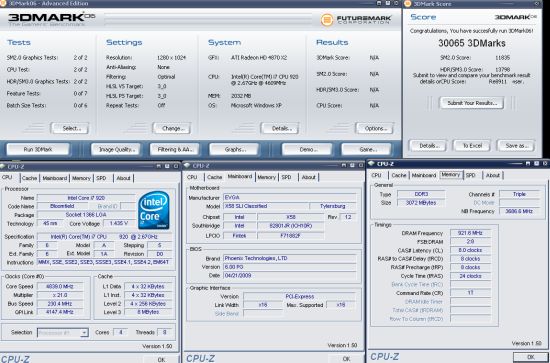 |
230 BCLK for the 3DMark06 CPU test in nothing to be sneered at - most C Stepping CPUs seemed incapable of this feat, along with a large majority of first generation boards based upon results across the forums. We had a hunch that something was holding us back, though, and luckily Corsair was kind enough to send us the coveted Corsair Dominator GT 2000 CAS 7-8-7-20 6GB kit to see if things could be extended further.
Abolishing Memory Limits
Previous tests had all been run using 3x1GB Kingston Hyper X CAS 9-9-9 2000 and G.Skill CAS 9 2000 kits. Oddly enough, we'd never managed to get either of these kits fully stable over 1900MHz with any of our 920 processors when pushing BCLK above 200, leaving us to believe that the IMC of the 920s we have were just not up to the task of these speeds. No amount of tweaking or voltage adjustments really helped either, leaving us stuck at clock speeds that were nowhere near the CPU's capability.
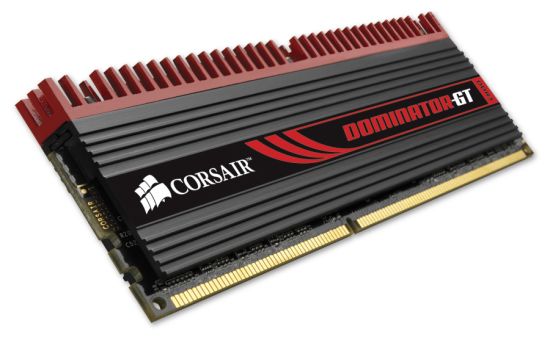
Inserting the Corsair Dominator GT modules ushered in immediate headroom on the 2:8 memory divider. Our previous best 231 BCLK setting for 3DMark06 gained an instant 11 BCLK using CAS 7-8-7-20 timings with a 6GB memory load. This is even more impressive given that the 231 BCLK run shown previously used CAS 8 timings on a 3GB kit that showed no potential for further scaling.
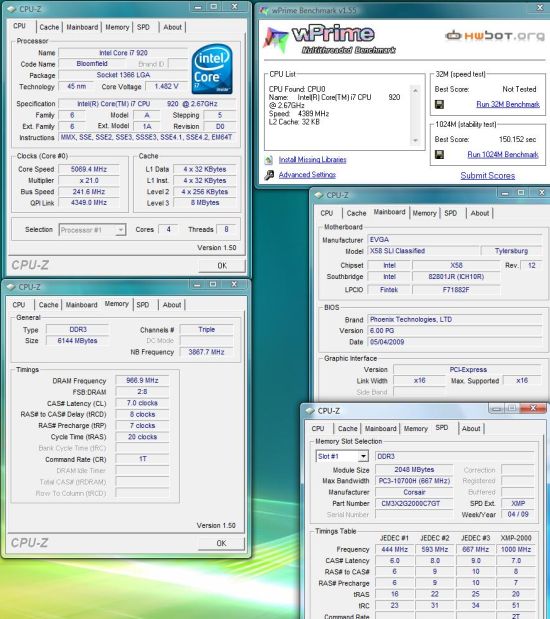 |
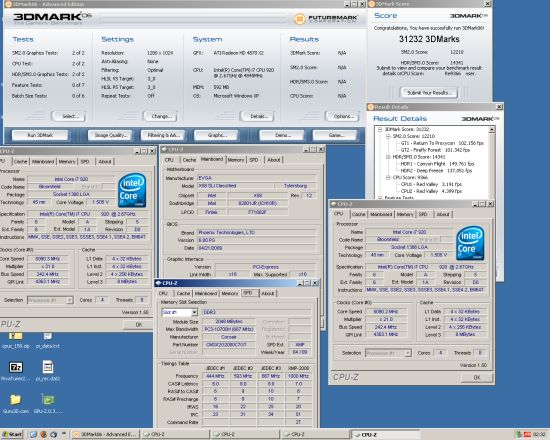 The combination of Classified and Corsair GT manages a very impressive 242 BCLK with HT on - again unheard of. |
We then focused on a maximum suicide shot for CPU-Z using the Corsair modules. We eased the load on the integrated memory controller by going to 8-8-8-20 timings to allow the CPU frequency to scale unhindered. The result is a 254BCLK for a 5.3GHz clock on the retail 920 CPU.
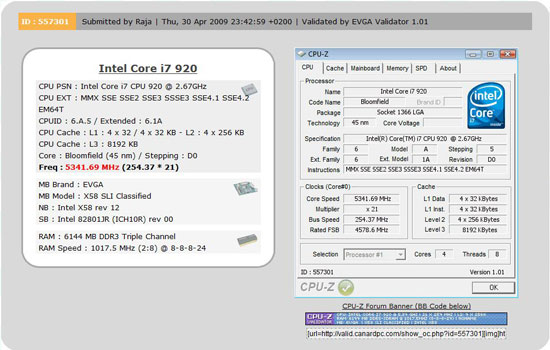 |
Taking Things Down Another Notch
Next up we were eager to see if using liquid nitrogen to cool the processor would allow further scaling in any of these benchmarks. A previous attempt at finding the "cold" limit of this CPU on the ASUS Rampage II Extreme had showed a maximum temperature limit of around -125C for booting from BIOS and a maximum -128C while idling within the OS (to be honest, other boards from several manufacturers fall into this same category and perform worse). However, this was misleading as it turned out the processor was capable of far lower temperatures on the Classified, which has onboard jumpers for disabling thermal motherboard cut-off thresholds.
Much to our surprise the CPU was capable of booting on the Classified at a brutally cold -160C, and being benchmarked all the way down to -190C during peak CPU loads; that's an instant 35C gain over the ASUS board. In the world of extreme overclocking, this is a big deal. The following picture pretty much says it all, with the CPU test of 3DMark06 running in the background with a pot temperature of -186C.
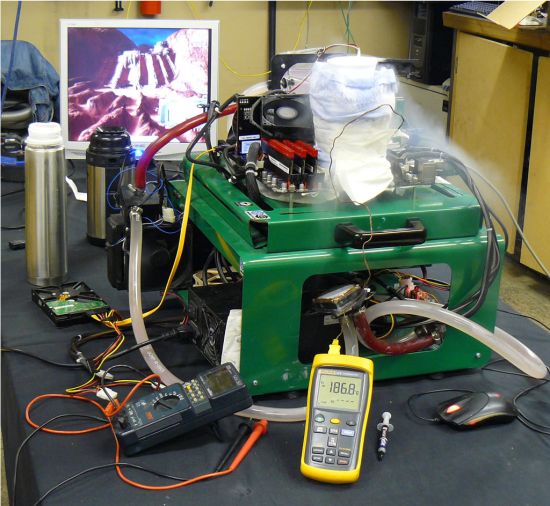 |
We only had approximately 15 liters of LN2 for the Classified testing, and with a little bit of BIOS voltage tinkering were able to extend our 3DMark06 run all the way out to a scintillating 248BCLK with HT enabled.
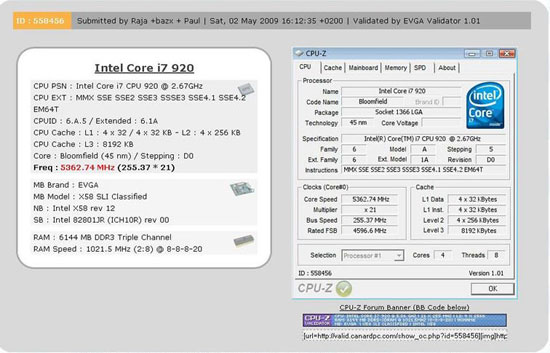 |
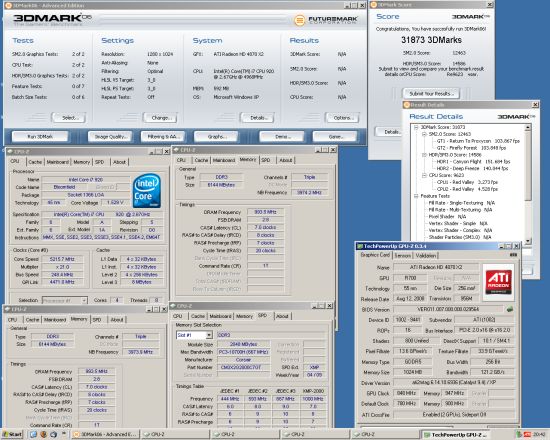 A landmark believed to be "unobtainium" is squashed by the EVGA X58 Classified, Corsair Dominator GT DDR3 modules, and a retail 920 D0 stepping processor. |
Final Words
Our experience with the Classified has been a very enjoyable to say the least from an overclocking viewpoint. Our retail board from EVGA has worked flawlessly throughout an extended test period in which we absolutely abused the board, and yet it came back for more. User experiences of the Classified have generally been excellent barring the occasional PSU compatibility and S3 fan resume problems. BIOS support has been excellent with any minor gripes solved as soon as they surfaced.
However, stock distribution into areas outside the USA seems to be limited and arrival slow. EU and Asia-Pacific product release has been hampered with EU availability being delayed several times. Boards have begun to trickle through to various distributors and retailers in these regions but widespread stock availability is still limited. Stepping up retail support in these territories would go a long way towards instilling end-user confidence that EVGA's USA support system is not a one-off affair. We are almost certain they have lost a number of adopters over the past few weeks due to availability problems in these regions.
The widespread release of Core i7-920 D0 stepping processors (with 950/975 due shortly) from Intel will certainly bolster the X58 platform appeal to users who are crazy about benchmarking. We have already discovered in early testing that the D0 stepping processors will not only allow higher overclocks (the 975 will be something special) at lower voltages, but the overclock consistency between each CPU is leagues better than the C0 stepping. Even though a "budget" 920 D0, Corsair Dominator GT, and X58 Classified motherboard seems like a pricing mismatch, the potential in this combination of parts is nothing short of stellar.
 |
We are proud to present the EVGA X58 Classified motherboard our Gold Editors' Choice award. We debated heavily amongst each other during the award process as the conveyance of this award for a motherboard with such single-minded focus on overclocking concerned us. Yet, that single mindedness by EVGA to develop and release a motherboard specifically for the overclocking community is what won us over in the end. In a market full of competitors all trying to outdo each other with the same basic X58 blueprint, it is refreshing for a manufacturer to step outside of the box and take a chance on a unique product. Yes, this motherboard is expensive and over the top in many ways, but you get what you pay for in this case. The EVGA X58 Classified is truly an outstanding product from both usability and engineering viewpoints. In addition, it also perfectly fits its market niche along with having some of the best customer support and service in the business. If your passion is subzero cooling, then we would stake our jobs on the simple fact that no currently available X58 motherboard is going to beat the EVGA X58 Classified for outright CPU clocking potential. The board is simply that good.
Now for the rest of us who utilize air- or water-cooling. You may find a slight advantage with the X58 Classified in terms of reduced system voltages and memory clocks over the mainstream motherboards. In reality, the gains are very small when you compare final overclock limits. Cooling is still king as always, and no board is going to bestow a magical 3GHz overclock upon you if your cooling is not worthy.
The i7's integrated memory controller takes a lot of the onus away from board level engineering until you really start to push very high QPI frequencies. Under a 4.5GHz CPU core speed it's difficult to discern any real differences between any of the enthusiast level boards in outright overclocking potential. It is when you get to the fringe of overclocking where a couple of nifty Classified BIOS functions that extend signaling margins really come into play. It's using these additional functions that has enabled us to benchmark our 920 D0 processor at QPI frequencies over 4.3Ghz under full eight thread loads. Couple the BIOS tweaks along with the subzero boot up workarounds and it is very difficult to look elsewhere when considering another X58 board designed for overclocking.
If we have to gripe (and we enjoy it at times), it has to be that the stock board cooling requires the end-user to supply their own fan before the board is really suitable to be used inside a PC case when overclocking. A 40mm fan in the retail package would not have broken the bank and would certainly earn the solution a few extra points. One also has to consider if adding the NF200 has brought anything worthwhile into the mix. Based upon our comparative benchmarks in the preview article, we would have to say no at this point, although it could help increase clock rates slightly.
The non-NF200 version is $50 less and based on the same board design and features. It should provide improved 3D scores in most setups but the jury is out on overclocking compared its big bother right now. Obviously, there is no getting around the cost of either board, as you simply must be in a different frame of mind to spend this much on a motherboard. However, having had the chance to use it, if you asked us if we would buy one we'd emphatically say yes. Simply because it is the only X58 board we have used that can truly bring out the maximum unhindered overclocking potential of the Intel Core i7. If that's what you're all about then look no further than the X58 Classified. It really is something special.












